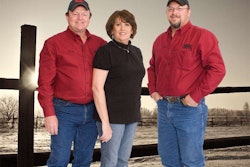Enhanced features on 90-to-less-than-135 horsepower wheel loaders give you exceptional performance for your primary jobs; add attachments and you have a true multi-purpose machine.
Core basics
First, let’s look at the core machine. Mike Murphy, product manager with New Holland Construction, says, “When it comes to carrying loads of material over a long distance and operating in a stockpile, both loading from and creating a stockpile, wheel loaders are hard to match.”
Loaders with selectable power modes, such as New Holland’s W110B with four work modes, match the loader’s performance to a specific task, material and environment. Another example is Komatsu’s WA150-6, which offers a new S-mode with variable traction control that adapts to various ground conditions and lets you move heavy, sticky snow. Unexpected tire slippage on slippery road surfaces is suppressed by controlling the engine speed and hydrostatic transmission motor when traveling at a low speed. The variable traction control feature is also valuable in slick waste transfer station applications. “You can never get too much traction,” says Mike Gidaspow, Komatsu product manager.
A wheel loader’s stability affects productivity, comfort and safety. Rear-mounted engines balance the front loads and ride control systems help cushion the operator and increase material retention. High-set cabs add to the loader’s weight configuration and give operators an unobstructed view of the work area.
For applications in tight spaces that require higher breakout forces and greater load capacities than those a skid steer can provide, a wheel loader can be the answer. Terex TL160’s articulating center point and oscillating rear axles combines an infinitely variable speed control system that provides maneuverability for work in space-restrictive and sensitive turf environments.
Enter new markets
Joe Zeno, president of ACS Coupler, says he’s advising his customers to turn over more rocks to look for projects that may be outside of their regular business. “If you have a coupler system on your machine, adding a new set of attachments opens up more opportunities for your company,” Zeno says. While residential building and commercial construction are still slow segments, Zeno reports he is seeing activity in scrap handling, railroad track maintenance and oil field construction.
A utility size wheel loader can operate class 20 and class 30 attachments (attachment manufacturers such as ACS and Rockland assign machine class categories that are determined by the loader’s breakout force, bucket capacity and tip load), which include these applications:
· Multi-purpose baskets for material handling, light grading, high dumping.
· Scrap grapples for handling ferrous and non-ferrous metal and demo debris.
· Clamp top forks (single, double, paddle) to handle long material like pipes and lumber.
· Loader rakes for loading trucks, moving demolition material, and storm cleanup.
· Jib booms to handle pre-cast pipe and manhole covers.
· Snow baskets for fuel-efficient snow hauling.
· Transfer station trash grapple buckets and tire grapples for recycling applications.
Quick couplers are standard on some wheel loaders, such as Komatsu’s WA150-6, but if your loader doesn’t have a coupler, or the coupler it does have accepts a limited number of attachments, aftermarket coupler systems in hydraulic and mechanical models are available, with some companies offering special order couplers.
“Adding a quick coupler or retrofitting a current coupler system on a wheel loader to accept attachments that are designed to perform with a customer’s specific wheel loader model allows him to bid on jobs he may have had to pass on in the past,” says Zeno.
Be aware, however, that not all attachments transfer easily from skid steers and compact track loaders to wheel loaders equipped with universal quick attach systems. “Because of the difference in auxiliary hydraulic flow between wheel loaders and skid steers or compact track loaders, it’s important to understand how your wheel loader’s driving, braking, steering and lifting functions may influence the performance of an attachment, particularly ones that require continuous hydraulic flow,” says Scott Sikkink, Terex ASV product marketing specialist. “Pay particular attention to the attachment’s hydraulic flow requirements. Continuous flow attachments like augers and brooms will not work efficiently if the loaders’ hydraulic specs don’t match the attachment’s needs.”











